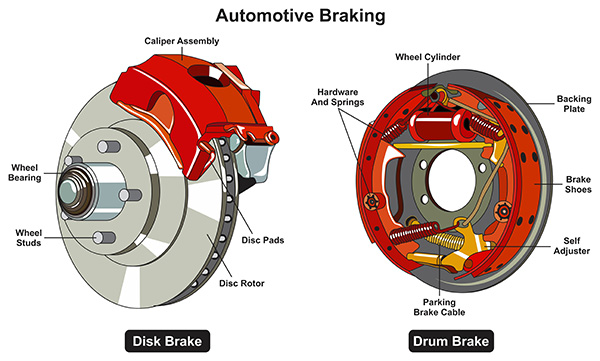
Brakes are one of the most important safety systems in any vehicle. We use them every day without much thought, but understanding how your car slows down and stops can help you recognize issues early and take better care of your vehicle. Whether you’re driving in city traffic or heading down a steep hill, your brakes are constantly working to keep you in control.
So how exactly do they work? Let’s take a closer look.
The Basics of Hydraulic Brake Systems
Most modern cars use hydraulic brake systems. When you press the brake pedal, it activates a master cylinder filled with brake fluid. This fluid travels through brake lines and applies pressure to the brake components at each wheel. The system is designed to amplify the force from your foot and evenly distribute it to stop the vehicle quickly and safely.
Without this fluid pressure, your brakes can’t function effectively—which is why keeping the fluid clean and at the right level is so important.
Disc Brakes vs. Drum Brakes
There are two main types of brakes used in passenger vehicles: disc and drum. Disc brakes are the most common and consist of a rotor (disc) attached to the wheel and a caliper that squeezes brake pads against the rotor to slow it down. This system is highly effective and offers consistent performance, even under stress.
Drum brakes, often found on the rear wheels of some vehicles, work differently. They use a set of shoes that press outward against the inside of a spinning drum to create friction. While they aren’t as powerful as disc brakes, they’re still effective and usually cost less to maintain.
Friction: The Key to Slowing Down
The force that actually stops your car is friction. As the brake pads or shoes press against the moving parts—whether a rotor or drum—they create resistance. This resistance slows the rotation of the wheels and brings your car to a stop. That’s also why brakes generate a lot of heat; turning motion into heat through friction is what makes braking possible.
Over time, the friction material wears down. That’s why brake pads and shoes are considered regular maintenance items—they need to be replaced periodically to keep your system working correctly.
The Role of the Brake Booster
Many cars use a brake booster to make braking easier. This component sits between the brake pedal and the master cylinder and uses vacuum pressure (or sometimes hydraulic or electric assist) to reduce the effort needed to stop the vehicle. If your brakes suddenly feel harder to press, the booster may not be working properly.
When the brake booster fails, stopping distances can increase, and the pedal may feel stiff or unresponsive. This is something that should be addressed promptly.
Electronic Assist and ABS
Modern braking systems often include anti-lock braking systems (ABS), which prevent the wheels from locking up during emergency stops. ABS uses sensors to monitor wheel speed and rapidly pulses the brakes if it detects a potential skid. This gives the driver more control while stopping quickly.
Many vehicles also have electronic brake distribution (EBD) and brake assist, which further improve safety by adjusting braking force between wheels and applying full pressure during a panic stop.
Westside Car Care – Reliable Brake Inspections in Yakima, WA
At Westside Car Care in Yakima, WA, we help drivers understand and maintain the systems that keep them safe—including their brakes. Whether you’re hearing squeaks, feeling vibrations, or just due for an inspection, our team can check every component and ensure your car stops the way it should. Book your brake check with us today and drive with peace of mind.